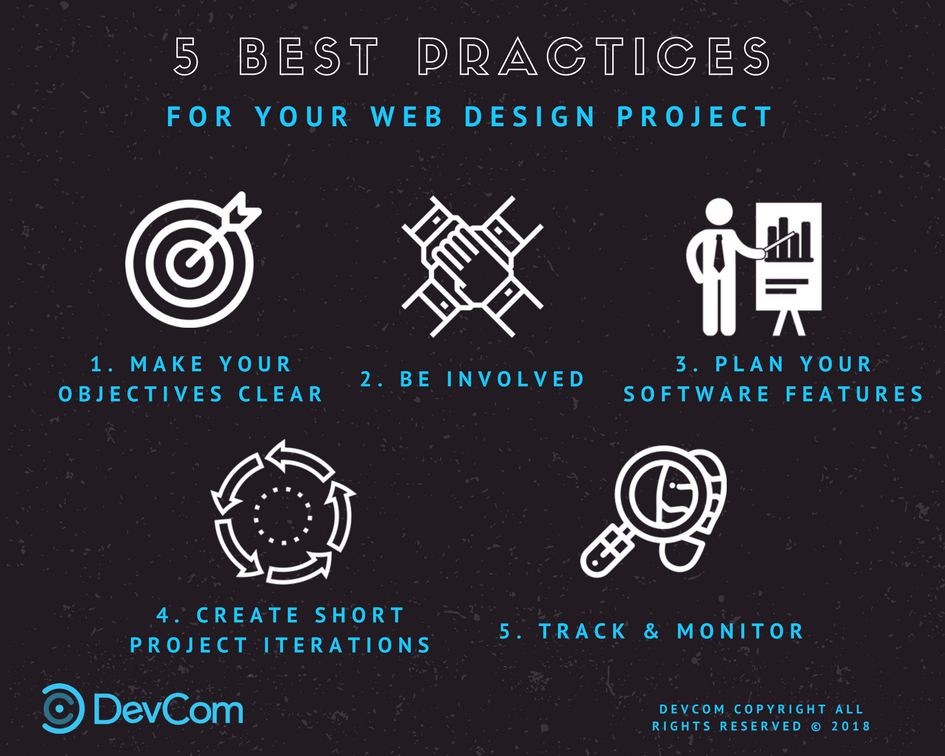Contents
It’s not a secret that web design projects are extremely prone to scope creep, unclear vision, and escalating costs. Therefore, every small business owner should keep his or her hand firmly on the tiller throughout the website development project. Furthermore, business leaders ought to strive for a close and effective partnership with the development team.

So, here are 5 best practices to follow so that your project stays on track:
1. Make your objectives clear
You need to be absolutely clear why you’re starting your web design project. What are the key goals that make this project worth doing? Are you trying to increase sales? Reduce costs? Minimize order processing errors? Your objectives need to be in line with your business vision. These objectives, also, need to be your idea fix throughout the development process.
It’s not enough to write a Request for Proposal and send it over to your development team hoping for clean cut, no trouble project delivery. You have to be an essential part of the process. Moreover, you’re the expert on your business; you know what makes your customers happy, and what drives them away. Finally, web development is a creative process with many new ideas and decisions being made throughout. So, in order to get the best out of your project, you need to be actively involved in it.
3. Plan your software by its features
Don’t take me wrong. You might think you know what features your software solution should have. Still, in most web design projects, new ideas pop up during the process itself. Some ideas come from discussions and reviews of early web design, and some — from new technology features and trends.
First of all, you should spend some time prioritizing the features according to your overall objectives and desired outcomes. Second of all, ask the development team for estimates broken down by entire features, rather than by tasks. This way, you’ll be able to swap old features for new ones. Finally, make sure the developers are always focusing on the top priority features that will take the biggest steps towards your goals.
4. Break your project into short iterations
You should break your projects into short iterations, and have the highest priority features developed first. With short iterations, you’ll be able to effectively make decisions about the direction the project is taking. Thus, you’ll be able to prevent your project going off the rails and call a halt quickly.
With each iteration, developers should completely finish both development and testing of a set of prioritized features. In this way, you will have the option of calling a halt to further development and having the developers focus on a certain feature set.
5. Don’t forget to track and monitor
At the end of each iteration, monitor the actual features that were completed, and compare this back to the original estimates. Estimation in software development is a black art, particularly when you are breaking new ground or the process is particularly creative. In short, being aware of the differential between actuals, and predicted estimates, will give you information to determine whether you need to re-plan the project. Moreover, frequent monitoring and re-planning will allow you to determine when you are ahead or behind the game. In addition, you’ll know whether to extend the project or cut out content to avoid uncontrolled project timescales.
Lastly, communication between you and web developers is absolutely critical! You ought to create an effective partnership with them, where you supply the vision and business knowledge, and developers – the technical know-how. In this partnership, you should work closely together in order to deliver a great solution, without allowing the project scope, timescales and costs to spiral completely out of control.
Keep in mind. DevCom has solid experience with web design projects. In case you have a similar project, share it with us.
For more helpful blog posts, you can check How You Can Benefit from a Chatbot or How to Write a Great Software Development RFP.





